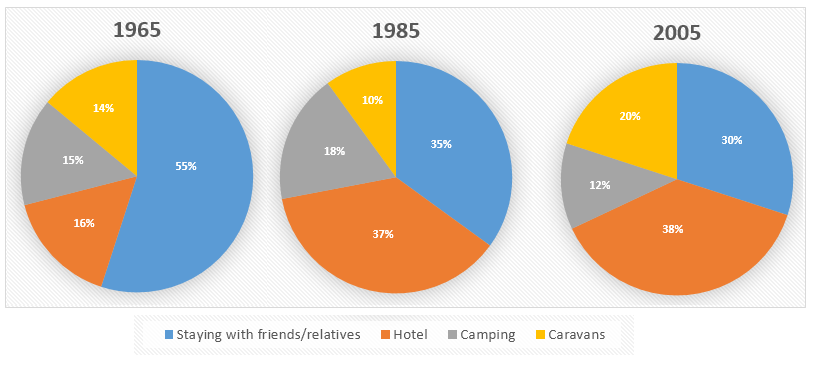» You should spend about 20 minutes on this task.
The charts show the proportion of holidaymakers of one region staying in different types of accommodation in three different years. Summarize the information by selecting and reporting the main features, and make comparisons where relevant.
You should write at least 150 words.

Sample Answer 1
The pie charts compare the ratio of holidaymakers from a region who used different types of lodging in 1965, 1985 and 2005. Overall, the hotel became the primary type of accommodation for the majority of the travellers in 1985 and 2005 despite most of the people’s preference to stay with a friend or relative.
According to the illustration, more than half of the holidaymakers from a region stayed in a house owned by a friend or relative in 1965. This ratio declined over the time and dropped to 35 and 30 percent in 1985 and 2005. A hotel was a preferred accommodation for 16% of these travellers and with time more holidaymakers started to live in a hotel. In 2000, more than one-third visitors stayed in a hotel. Camping while enjoying holidays was chosen by 15% people in 1965 and after two decades it was preferred by 18% holiday seekers. The popularity of camping seems like decreased in 2005. Finally, 14% visitors picked a caravan as an accommodation in 1965 and their ratio decreased to 10% in 2 decades but doubled in 2000.
Sample Answer 2
The pie charts outline the percentages of holidaymakers from a particular region in terms of their preference of accommodation over a span of four decades, starting from 1965. It is noticeable that people shifted their tendency to stay at a friend or relative’s house in favour of staying in a hotel.
As is given in the illustration, 55% holidaymakers stayed with friends and relatives in 1965 while 16% preferred to stay in hotels. Camping and caravans were picked by 15% and 14% respectively in this year for their lodging during their holidays.
After two decades, people who stayed at a relative or friend’s house dropped to 35% while 37% stayed in hotels. Preference of camping increased by 3% while caravan use declined.
Finally, in 2005, fewer percentages of people stayed with friends and relatives during their vacation and 38% favoured hotel accommodation. This year camping was their least ideal option while caravan’s use doubled than that of 1985.
